Best Corded Drill Driver — Buyers Guide, Top Pick, and Comparison
For light-contractor work and home-improvement applications, the corded drill driver is an invaluable tool. Offering the twin functions of driving and drilling from a single machine, it can bore into acrylic, metal, and timber — while also permitting you to tightly fix bolts and rapidly drive screws. And, being mains-powered, it provides unwavering long-term use, unlike its cordless cousin. Compatible with a plethora of head accessories, in addition to driving and drilling, you can use the machine as a polisher, grinder, buffer, and honer.
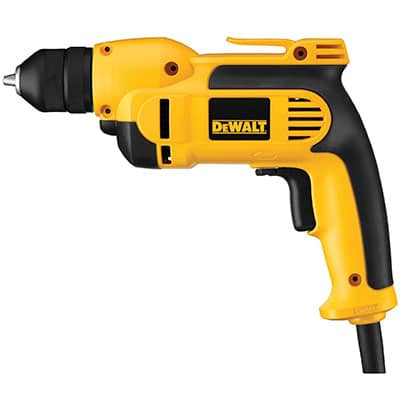
- Durable ball-bearing construction.
- Solid bit retention.
- Cord protector.
Electric Drill Driver Product Comparison Table
| IMAGE | PRODUCT | DETAILS | ||
|---|---|---|---|---|
|
Best Keyless Chuck Drill Driver 
|
Best Keyless Chuck Drill Driver
|
DeWalt DWD112
|
Features
|
Check Price at Amazon Review DeWalt DWD112 Review DeWalt DWD112 Review |
|
Best Electric Drill Driver for Grunt 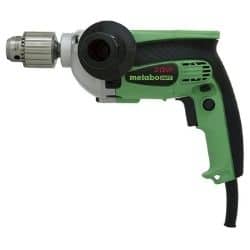
|
Best Electric Drill Driver for Grunt
|
Metabo HPT D13VF
|
Features
|
Check Price at Amazon Metabo HPT D13VF Review Metabo HPT D13VF Review |
|
Top Electric Drill Driver for Large Bits 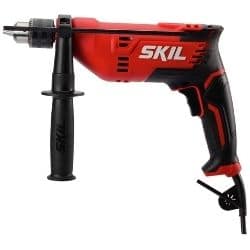
|
Top Electric Drill Driver for Large Bits
|
SKIL DL181901
|
Features
|
Check Price at Amazon SKIL DL181901 Review SKIL DL181901 Review |
|
Best Budget Wired Drill Drivers 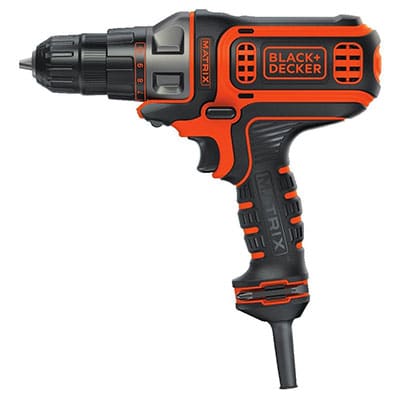
|
Best Budget Wired Drill Drivers
|
Black and Decker BDEDMT
|
Features
|
Check Price at Amazon Review Black and Decker BDEDMT Review Black and Decker BDEDMT Review |
|
Best Heavy Duty Electric Drill Driver 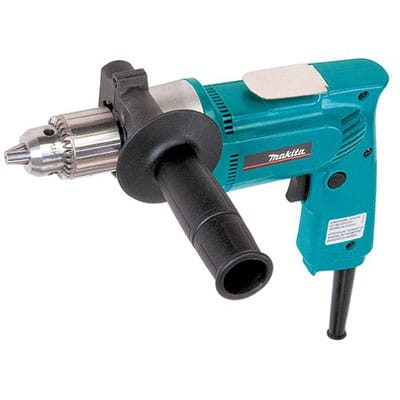
|
Best Heavy Duty Electric Drill Driver
|
Makita 6302H
|
Features
|
Check Price at Amazon Makita 6302H Review Makita 6302H Review |
|
Best Corded Drill Driver for Speed 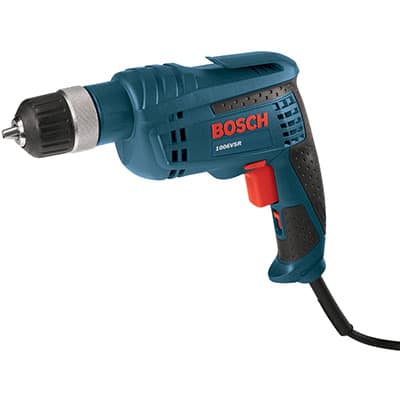
|
Best Corded Drill Driver for Speed
|
Bosch 1006VSR
|
Features
|
Check Price at Amazon Bosch 1006VSR Review Bosch 1006VSR Review |
Best Corded Drill Driver Buying Guide
If you need a multi-function boring and driving tool — without the headaches of recharging power cells — then consider a corded drill driver unit.
Suited to both drilling holes and driving screws and bolts, these mighty machines can knock out speeds up to 2600 rpm and a beefy grunt delivery up to 416 in-lbs (inch-pounds).
Ranging from casual-use budget models through to industrial-grade torque-busting behemoths, there’s a unit for every user and drill/driving project. And, unlike their battery-operated cousins, you can run these units straight-outta-the-box — requiring no additional purchase of cells or chargers.
When choosing your ultimate electric drill driver, consider:
- Keyed or keyless chuck.
- Two to four times faster than a standard pillar drill.
- Speed output.
- Torque intensity.
- Chuck diameter.
- Length of the cord.
- Included secondary handle.
- Reversible clutch.
- Build quality.
- Unit weight.
What Is a Corded Drill Driving Unit?
Like the moniker implies, these units offer two key functions — driving and drilling.
As a boring machine, these tools boast sufficient brawn to drill into plastics, sheet metals, ply, and acrylics — making them excellent for the DIYer. Their main downside is they lack the durability and grunt to tackle masonry and brickwork — for those jobs you need a hammer or rotary machine.
For driving applications, they offer a similar function to an electric screwdriver — but with greater rotational velocity, elevated torque, and more user-tailorability. Their trigger-throttle control permits you to adjust the speed and power to suit your target medium — preventing screw/nut head shearing and timber splitting.
Furthermore, this rotational flexibility means you can use these machines with a multitude of spinning accessories — such as sanding points, brushes, mixers, polishers, and grinding wheels.
All sounds straightforward, right?
Well, it is until you hit upon perhaps the most hotly debated topic in the drilling world — do wired drill drivers actually exist?
The Corded Electric Drill Driver Controversy
Remember Schrödinger’s cat? This unfortunate kitty was both alive and dead at the same moment in time.
This is similar (well somewhat, but without the quantum physics or an unlucky feline) to a corded driver drill. At the same time, they can be drill drivers, and they can’t.
Here’s the issue.
For a tool to be called a cord drill driver, it unsurprisingly requires three basic features — a cord, an ability to drill, and the capability to drive. However, that covers virtually every mains-powered borer on the market.
As long as the power tool features a chuck head that can accommodate cutting bits and screw/bolt bits — it can drill and drive. But, that doesn’t mean it’s equally suited to both. Hence, many mains-lead drills advertised as drill drivers are, in fact, just standard electric machines.
A true and best electric drill driver needs the versatility to perform the dual function satisfactorily, meaning that they:
Deliver suitable speeds for boring — typically over 1000 rpm.
Sufficient torque to drive bolts and screws.
Variable speed starting at zero rpm to prevent screw head damage.
Reversible clutch to remove screws.
Compact to address nuts and screws in confined spaces.
Sensory clutch that detects when the screw is fully tightened.
Small head to accommodate screw bits.
Finding a corded drilling tool that meets all of these specifications can be challenging — although through hours of blood, sweat, and tears we have managed to find the best corded electric drill drivers on the market — illustrated in the table above.
Conversely, the cordless drill driver niche is much more straightforward, with models specifically designed to both bore and tighten — not as an afterthought or lucky accident.
Corded Drill vs Cordless Drill Driver
Undoubtedly, battery-powered drill drivers have the lion’s share of the dual-function market. Their cordless function combined with their compact build makes them superior drivers to their corded cousins — able to access the awkward and confined spaces where screws and bolts typically reside.
Furthermore, their keyless 0.375-inch chucks make them more suited to securing small screw driving heads — as opposed to the keyed 0.5-inch heads typical on many so-called corded drill drivers.
However, that’s not to say there are no perks to mains-powered models. Many driver corded drill reviews extol their virtues, with the advantages of:
- More affordable than cell-driven units.
- Usable straight-outta-the-box requiring no additional purchases.
- Typically more powerful and faster than cell machines.
- Allow for continuous operation without recharging.
- Lighter than cordless units as there’s no battery.
- Longer lifespan — a typical lithium-ion cell lasts around three years.
- Easier to maintain than battery-powered models.
Uses for Variable Speed Corded Drill Drivers
- Cabinet construction.
- Boring into plastic, timber, and ply.
- Attaching shelves.
- Engine bay work.
- Tightening bolts.
- Driving screws.
- Sanding.*
- Mixing plaster.*
- Rust removal.*
- Intertwining wires.
- Laying decking.
- Erecting fencing.
- Securing drywall.
*requires a suitable attachment
How to Choose the Best Power Drill Driver
Hence, when selecting your ideal machine, it’s essential to consider the requirements of your projects, as well as your own personal preferences.
I recommend that you look at:
Keyless or Keyed Chuck
Unlike cordless drill drivers which almost exclusively feature keyless chucks, corded models are available in both keyed and keyless formats.
While the main advantage of keyless models such as the Bosch 1006VSR is practicality (as there’s no tightening tool to lose), they can suffer from bit instability. While not generally an issue when driving, if you’re drilling into dense mediums with a large bit — you want the ultimate security offered by a keyed chuck, as exemplified by the Metabo HPT D13VF.
Hence, when choosing your corded driver-drill, consider how much hole boring your projects entail.
Chuck Size
Mains-driven drill drivers offer either a 0.375-inch or 0.5-inch chuck — the optimum size depends on your work requirements.
Units like the Black & Decker BDEDMT boast a 0.375-inch bit head — making it suitable for standard metal and wood bits, plus screwdriving heads. Usually, this diameter chuck is ideal for casual and general DIYers completing home projects.
Other machines, for example, the SKIL DL181901, have a 0.5-inch chuck. This larger capacity means you can utilize wider diameter bits — useful if you’re boring pipe or wire channeling.
Torque and Speed
Opting between speed and torque is a trade-off — it’s impossible to have both. As speed increases, torque decreases, and vice versa — a subject that’s explained fully in my Torque Vs Speed article.
If the majority of your jobs involve driving or drilling into thick metals or dense hardwood, you require a seriously grunty torque-focused machine — such as the Metabo HPT D13VF that delivers 416 in-lbs of brawn, but with a relatively low maximum speed of 850 rpm.
Alternatively, should your projects feature repetitive screw driving into soft timber — as when making furniture or building fences — choose a low torque/high-speed corded machine such as the 2600 rpm Bosch 1006VSR.
Whether you go for a high speed or high torque machine, always ensure that the rapidity and grunt are variable — allowing you to adjust the output to perfectly suit your target medium.
Cord Length
Unlike their battery-driven siblings, electric driver drills require access to a mains outlet. This means that cord length is crucial — the longer the power lead, the further away from the socket you can operate.
That said, it’s unusual to find a corded model with a cable longer than eight feet — necessitating the use of an electrical extension. Always check that the amperage rating of your machine matches the rating of any extension cords.
Auxiliary Handles
Some electric drill/drivers feature a side-mounted secondary handle — for example, the Metabo HPT D13VF. This allows you to tackle more stubborn dense mediums by permitting greater pushing power, while also heightening accuracy.
Conversely, small electric drill driver units — such as the Bosch 1006VSR and DeWalt DWD112 — lack an auxiliary handle. This makes them much more compact, and more suited to accessing confined spaces for screw driving.
Reversible Clutch
One of the most crucial features to look for in a drill driver, especially if you’re planning on using the machine on screws and bolts. Typically a sliding bar switch mounted in the middle of the drill casing, permits you to put the machine in reverse — essential when unscrewing or unbolting.
Some units, for example, the Metabo HPT D13VF, boast an oversized switch, allowing you to effortlessly change drilling/driving direction with a thumb movement — meaning you can operate the tool single-handedly.
Durability
Corded electric driver drills usually focus on three markets — the casual user, the experienced DIYer, and the trade professional.
Their casing construction, quality of the internal components, and availability of spare parts vary across these three target areas — which affects their durability.
Hence, you can purchase a cheap power drill — like the Black and Decker BDEDMT — for less than $40 dollars. And while ideal for intermittent use, it will not be resilient to hardcore work and knocks and bumps as a pro-grade unit, unlike the heavy-duty Makita 6302H. However, more robust drills such as the Makita come with a concomitant price tag.
Weight
Compared to battery-powered drill/drivers, the corded models have the advantage in weight. Lighter than their cordless counterparts — as you’re not carrying a lithium-ion cell in addition to the drill itself — they can be more suited to longer jobs where hand and arm fatigue could become an issue.
That said, the weight of individual corded models can vary — from a lightweight 3.1 pounds in the Black and Decker BDEDMT, through to a seriously hefty 8.0 pounds of the Metabo HPT D13VF.
Additional Features
While not dealbreakers, many corded driver/drill power tools feature useful additions or characteristics that may be important to you or your projects. Look out for:
- Reinforcing cord protector.
- Hanging loop.
- Belt clip.
- Included oil, case, or drill bits.
- Rubberized handle.
- Depth gauge.
Conclusion
Offering the DIY essentials of boring and screwdriving — the mains-powered drill driver is the consummate home-improvement tool.
With greater power consistency, plus higher torque and speed than their cordless counterparts, these machines are as suited to cabinet making as they are shelf-mounting.
When selecting your ideal unit, primarily consider the torque and rpm output — dependent on your job’s demands. Furthermore, ponder whether you require a standard 0.375-inch chuck or a large diameter bit compatible 0.5-inch driving head.
Admittedly, these corded tools aren’t going to appeal to all users. Lacking the freedom of operation offered by the battery-powered machines, they require use near a mains outlet and are awkward to use up ladders or on scaffolding.
However, for guys who prefer the reassurance of unwavering power at a price typically lower than a cell unit — it’s worth checking out the corded drill driver machines.

Corded Drill Driver FAQs
Q: What Is the Best Corded Electric Drill Driver?
In my opinion, and as justified by a multitude of electric drill reviews, the best driver drill is the DeWalt DWD112. It possesses a powerful 8.0 amp motor that knocks out speeds up to 2500 rpm and incorporates a 0.375-inch keyless chuck.
Q: Are Corded Drills More Powerful Than Cordless?
In most circumstances, yes. For similar amp-rated units, mains-powered models deliver higher torque and speed than their battery-driven siblings. Furthermore, their grunt doesn’t decrease as with a draining lithium cell — and they prevent downtime with no recharging requirements.
Q: Can I Use a Standard Corded Drill as a Drill Driver?
The majority of mains-powered drills are unsuitable for use as a drill-driver. The unit requires two key functions — variable speed to ensure controlled tightening, and a sensory clutch that drops torque when it senses resistance, preventing damage to the screw head.
Q: What Is Drill Driver Used For?
You can use a drill driver for boring into metal, plastic, and wood, plus driving screws and tightening bolts.
